A global S-trough potential stability
Let us now consider in the most general form the entire S-interval of the Universe from \(10^{-33}\) cm to \(10^{28}\) cm from the standpoint of large-scale dynamics. For this purpose, let us return to the previously proposed scheme (see Fig. 1.7). Recall that, according to the author's HYPOTHESIS, the three main types of interaction divide the S-interval of the Universe into three identical sections (see Fig. 1.9).
Let's pay attention to the fact that on the right plot (B-C) dominating GRAVITATION forces create mutual attraction of all objects. There are no gravitational forces of repulsion. Hence, it is easy to conclude that the right site (hereinafter referred to as the slope) is dominated by gathering tendencies, in which the objects converge and are concentrated in space. As a result, the initial material system shrinks and becomes smaller. Within the logic of scale dynamics, it follows that the LEFT VECTOR of M-Force dominates on the right third of the S-interval of the Universe, which tends to move all systems along the S-axis to the left (recall once again that a decrease in size corresponds to the movement of the system along the S-axis to the left, and an increase - to the right). In passing, recall that such a process can proceed both with a change in the density of the initial components and without a change in their density. For example, a diffuse nebula is compressed under the influence of gravitational forces. At the same time, its density increases. The density of atoms, molecules and dust particles, of which it consists, remains unchanged. At a certain stage of compression, its central region turns into a star, and peripheral - into planets. The atoms, molecules, and dust particles in the planets have essentially the same initial density. In principle, there is little change in the density of these components inside the star as well. Therefore, this whole stage can be called the assembly stage, although for the whole diffuse nebula this process can be called compression. The process after the death of a star is somewhat different. Gravitational forces compress its core to a white dwarf (WD), or to a neutron star (NS), or to a black hole (BH).
In the first case, the density of atoms increases by orders of magnitude because the volume of atoms sharply decreases when they are compressed. In BH, the atomic structure of the substance is practically destroyed. In the second case, the density increases by many orders of magnitude more, because the matter of NS is a solid "mush" of nucleons. In NS the nuclear structure of matter is already destroyed.
In the third case, the density of matter increases by many orders of magnitude and the nucleons themselves are destroyed. Practically, in BH the matter structure is destroyed, because at such monstrous pressures and densities no elementary particle can "survive". One can BELIEVE that BHs consist of only maximon. The above examples allow us to emphasize once again the fact that gravitation, if it is not counteracted by other forces, leads to only one process - compression, and consequently - to the motion of the system along the S-axis from right to left.
Let us now turn to consideration of the trends dominating in the middle section of the S-interval (A-B). Here ELECTROMAGNETIC INTERACTIONS predominantly "work". Since in the case of identical charges the systems repel each other, and in the case of different charges - attract, it can be stated that in the middle section of the Macro-interval two S-vectors - left and right - "work". The left one reflects the situation with attraction of two different charges, and the right one - with pushing of two identical charges. Any macro body can have either a predominantly positive charge or a predominantly negative charge. Therefore, these two vectors are characteristic for the whole section of the Macro-interval. Let us now turn to the left, Micro Interval (0-A). Here, as we have already shown earlier, exclusively weak interactions dominate. Recall that "...the main "profession" of weak interactions is not the creation of forces, but the realization of decays (italics mine - S. S.) of particles" (Shirokov Yu. M., Yudin N. P. Nuclear Physics. Moscow: Nauka, 1972. С. 356.). I.e. on the left edge of the S-interval of the Universe the tendencies connected with deconcentration, with expansion of objects dominate. It is obvious that this process can be compared to the RIGHT S-VECTOR.
In general, the whole picture of dominant trends can be naturally represented as the GLOBAL POTENTIAL S-Trough OF stability OF THE UNIVERSE, or S-Trough (see Fig. 2.22).
What is the convenience of such a MODEL? Because in it the tendencies to contraction or expansion are modeled by tendencies to roll down of systems, to a more stable state, to the center of the S-interval. A ball on the left slope of the S-Trough will tend to roll to the right, while its size increases (e.g., a particle is decaying). The ball on the right slope of the S-trough will tend to roll to the left, at that its sizes will decrease (for example, there is a collapse of the star's core).

Fig. 2.22. Global S-Trough of Potential stability (STPS) on the S-Axis of the Universe, showing transitions between different types of interaction (simplified model)
In the central part of the S-interval, the ball can be in an oscillatory state (pulsating, disintegrating- reassembling, etc.).
It is very important to note that practically only one principle was used in constructing the model of the global S-Trough of the Universe - the PRINCIPLE OF SCALE SYMMETRY. In this case, the mirror axis of symmetry is the axis passing through the S - Center of the Universe - SCU. In addition, we note that on a narrow half-order band - at the junction of the Microinterval and Macrointerval - the strong interactions dominate, which are mainly responsible for the compression of nucleons in atomic nuclei. Their vector is opposite to the vector of weak forces.At the junction of the Macro-interval and Mega-interval, as we suggested earlier, the pushing forces of the FIFTH force unknown to science may act, also on a narrow strip of half-order.
So, we can PROVE that any process occurring with increasing size on the left slope can find a mirror antipode on the right slope occurring with decreasing size.
The question arises: are there only processes of compression and connection of systems on the right slope? Certainly, if only gravitation acts, it would be so. But the thing is that in the Universe the process of compression, as a rule, is balanced by the process of expansion. Any star would instantly shrink under the influence of gravitational forces, if it were not for the internal pressure caused by the processes going on at the level of the microcosm (the left third of the S-interval). Any planet would be compressed by gravity to a minuscule size, but the force of electromagnetic repulsion between atoms prevents this from happening. Conversely, the overabundance of internal forces of the microcosm sometimes leads to such grandiose explosions that not only star systems but also galaxies fly apart (see Fig. 2.21). This collapse of such large systems, their "disintegration", goes on the right slope, goes against gravity, against the general tendency, and therefore it occurs explosively, catastrophically, instantly. Using the principle of mirror symmetry, we can PROPOSE that on the left slope there can also occur a catastrophic (almost instantaneous) process with the opposite sign - the collapse of particles.
FREE RETREAT
Thus, if gravitational forces are responsible exclusively for the compression of matter, and weak forces are responsible for its decay, then the electromagnetic forces quite logically share the processes of compression-expansion (attraction-repulsion). Let us consider once again the model S-Trough of Potential stability for the Metagalaxy (see Fig. 2.22).
On the large-scale "territory" of weak (pushing) forces we see a small strip of very actively compressing forces - strong interactions. If we accept the principle of mirror scale symmetry, we can find a place for the hypothetical fifth force, which should be responsible for the pushing of hypothetical gravitational clones in the nuclei of stars and planets. Conditionally speaking, these are "strong antigravity" interactions. At closer examination it turns out that the obtained scale scheme surprisingly resembles the well-known oriental scheme of forces: Yin-Yang.
After all, the symbols YIN and YANG bear a semantic load very close to the problem under consideration. Thus, YIN among other things, is expansion. YANG is compression1. In addition, YIN is inside, space, bottom, woman... and YANG is outside, time, top, man (see Fig. 2.23).
If we consider the S-axis traditionally vertically, then the heavens and the cosmos will be at the top, and the microcosm will be at the bottom. If a human being is placed on a point of his size - \(10^2\) cm, then everything that will be below this point can be referred to his inner world, as it contains cellular, molecular, atomic and other levels. Everything that will be above this point - will have to do with the external world of a person. Isn't it true that many things coincide? Inside the substance there are weak (female) forces responsible for expansion, they dominate at the bottom of the S-axis. Outside of man there are gravitational (masculine) forces responsible for contraction, they dominate at the top of the S-axis. At the same time, the female forces appear lower than the male forces on the S-axis in exact correspondence with the location of the "female point" on it - the average height of women is lower than that of men, so the female point on the S-axis is slightly lower than the male point. The most interesting thing consists that on space of Yin forces there is a small Yang spot responsible for compression - strong interactions. Then, according to the principle of mirror symmetry, there should be a symmetrical narrow spot of some pushing antigravity forces on the space of Yang forces (see Fig. 2.23).

Fig. 2.23. Global S- Trough of potential stability on the S- Axis of the Universe showing transitions between different interaction forces.
So, we see that a detailed study of the role of interactions on various scales unwittingly leads science to an ancient esoteric scheme, with the ability to make predictions about a fifth force as yet unknown to it.
But that's not all. There is a well-known philosophical principle: extremes converge. It has a confirmation for the S-Trough as well. In the region of sizes smaller than \(10^{-33}\) cm, according to M. A. Markov's model, we get into another Universe, and consequently, we enter the world of gravitational forces, but inside another Universe. On the other hand, our Universe is, according to M. A. Markov, just a maximon for the metauniverse, which again will stimulate expansion and sprawl in its microcosm. Hence, from gravitation we pass to quasi-weak forces of this metauniverse.
If we do not use the exotic model of M. A. Markov, but rely only on the calculated force ratio2, we will also see that at the size of the maximon gravity again becomes significant! Gravitation, which becomes negligibly small already on the scales of \(10^{-13}\) cm as we dive into the microcosm, suddenly revives like a phoenix from the ashes after diving 20 orders of magnitude further!
So, it is possible that, having closed the S-Loop, gravitation from its limiting size of \(10^{28}\) cm reappears, but already in the microcosm, inverting into its opposite - the "pushing" forces.
For the size of the Metagalaxy, according to M. A. Markov's model, an inversion can occur - the Metagalaxy becomes a maximon for the Universe of the next scale level (if its scale "scope" is similar to the "scope" of our Universe, its size will be amazingly large in our metric - \(10^{89}\) cm).
So, in general, a general trend is realized in the Universe:
- in the left third of the S-axis, weak forces tend to scatter matter through space (repulsion and division forces prevail);
- these weak forces find their mirror counteraction in the right third of the S-axis, where gravitational forces have only one sign - attraction;
- in the central third of the S-axis, the two tendencies are intermixed: the electromagnetic forces have both the sign of attraction and repulsion.
The obtained model of the global S-Trough leads to the idea of a simple principle uniting three forces in the Universe. These three forces are just components of ONE UNIVERSAL LARGE-SCALE FORCE or S - UNIVERSAL FORCE (SUF).
To go further, let's put forward the following HYPOTHESIS.
There is a constant BIRTH of NEW PARTICLES OF Matter in the Universe due to the action of Weak Forces..
Through what and how this process can take place, we will look at the following sections.
It follows from the new HYPOTHESIS that from the left slope of the S-Trough all new systems possessing the kinetic energy of scattering from the center of "injection" are constantly "rolling down". They may well skip by "inertia" the center of the S-Trough and get to the right slope, from where they may roll back, being compressed by gravitation. In such a model, it is as if the S-Pendulum is working. The potential limiting amplitude of oscillations for all the matter of the Universe is no less than 61 orders of magnitude. All this can be represented in the form of a purely mechanical model of a ball arrangement on a smooth surface of the S-Troughs, having lowered it from one edge, we will get a constant oscillation of the ball near the center of stability. The complete cycle of such oscillation forms as if a scale loop (S-Loop) (Fig. 2.24).
How to combine this model with the previously discussed S-THROUGHs of each scale class?
There is only one option: to consider the general SYNTHESIS-DIVISION MODEL AS FRACTAL. Then the S - GLOBAL TROUGH (SGT) is the first upper level, the NUMBERED S-TROUGHs are the second level, on the surface of the numbered S-TROUGHs there can exist their local S-TROUGHs of the third level (see Fig. 2.25). Due to this structure, a potentially possible global universal S-CYCLE is split into many local S-CYCLEs, which can be represented as local S-TROUGHs.
Fractality creates a much more complex multistage, cascade process of substance transformation during its movement in S-TROUGHS. Simple schemes of numbered S-TROUGHs are just one slice of a complex multilevel phenomenon.
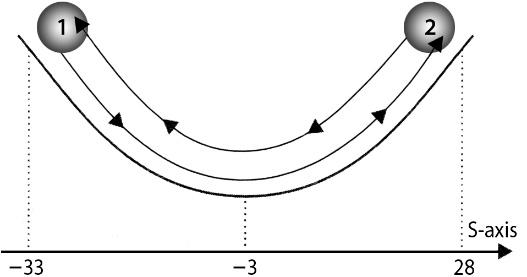
Fig. 2.24. The general dynamics of the Universe can be represented by a closed S-Loop. Vacuum-born particles, flying in different directions, gather back due to gravitation, which can eventually lead to the formation of a black hole consisting of primary maxima. In the same way the Universe, expanding from a primary particle, can return back to the initial state (model of the Pulsating Universe with a Bounce)
If we leave the model representations and go to the three-dimensional images familiar to us, we can build the following picture. From the depths of matter (from the microcosm) all new substance is constantly bursting out (created from maximon) and all new energy is flowing out (potential energy of the maximon connection is released) - the points of space seem to exude substance and energy from themselves, scattering them around.
As a result of addition of all local processes as a whole, the "universal balloon" is inflating. This "balloon" would be blown into small splashes in the void, if gravitational forces "hoop" would not pull matter together, would not gather it into planets, stars and galaxies. Thus, GRAVITATION in this model can be considered as a kind of STRUCTURAL TENSION OF SPACE.
Now let us describe this process using the model of the global S-Trough. The physical vacuum gives birth to all new, ever larger particles. There is a continuous birth of matter (at conservation of matter and energy), which we perceive as birth only because the lower floors of matter are hidden from us in the darkness of ignorance and unseeing (see Fig. 2.26).
In general, in the microcosm there is a constant growth of the size of systems due to expansion, due to the connection of small particles into larger ones. "Born" particles do not appear out of nothing, they are formed in the course of a complex "construction" of maximons on invisible for us floors of matter (in Dirac's basement). The moment of their birth is only a transition by them through the boundary of our knowledge, through the horizon of the microcosm, through that horizon, the passage through which from the bottom to the top makes matter a substance in our usual sense.
METHODOLOGICAL DEPARTURE
Here it is necessary to define the terminology. Hereinafter we will call as matter everything that consists of maximons. Matter will be divided (rather conditionally) into two types: matter and ether. By ether we will understand a medium of maximon. By matter we will understand stable constructions from maximon, the density of which is lower than the surrounding ether.
At the other large-scale edge of the Universe, the opposite process is going on. Everything that is scattered by the microcosm is collected by the megamir, it strives to return everything to the center of the S-Trough of Potential stability. Both processes are accompanied by the release of energy, because ANY decrease of CAPACITY (height) in the S-Trough is accompanied by the release of free energy.

Fig. 2.25. The surface of the global S- trough at closer examination can appear fractal, i.e. covered with secondary, tertiary, etc. troughs of stability. Therefore, any dynamics in the Universe can have a cascade-stage, quantum character
Both processes can not stop in the SCU, but by inertia skip the lower stability point, i.e. both processes can go through, through all levels of the Universe structure, towards each other, and these processes are peculiar for all levels of scales (without exception), for all kinds of systems. But due to the fact that in a number of systems these two global processes are hidden in the depths of structural levels, they may not be directly observed.
There are, however, such levels of organization of the Universe at which these processes manifest themselves visually. Then S-Loop has a vivid natural embodiment.
For example, large-scale loops can be observed on the surface of the Sun. These are prominences, or giant emissions of the Sun's excess energy, which is released due to processes occurring at the deep levels of its matter structure (see Fig. 2.27A).

Fig. 2.26. Matter in the range from \(10^{-15}\) cm to \(10^{28}\) cm is perceived by science as a material Universe, while in the Dirac basement, in the range from \(10^{-33}\) to \(10^{-15}\) cm, it is perceived as an unstructured non-material substance - vacuum, which is a conductor of all kinds of fields. But, most likely, this basement has its own complex hierarchical dispersed structure, which is not perceived as such because it is "behind" the large-scale horizon of penetration of human cognition
If one examines the life of the Sun over a long enough period of time, it will be seen that it is all surrounded by a layer of prominences - fountains of matter and energy that fly out from inside the star and back again.
Together, the prominences form a kind of energy-matter "coat" around the Sun (see Fig. 2.27B). Each individual prominence is a magnificent symbol of the M-loop. Such "fountaining" should be a common phenomenon for all stars.
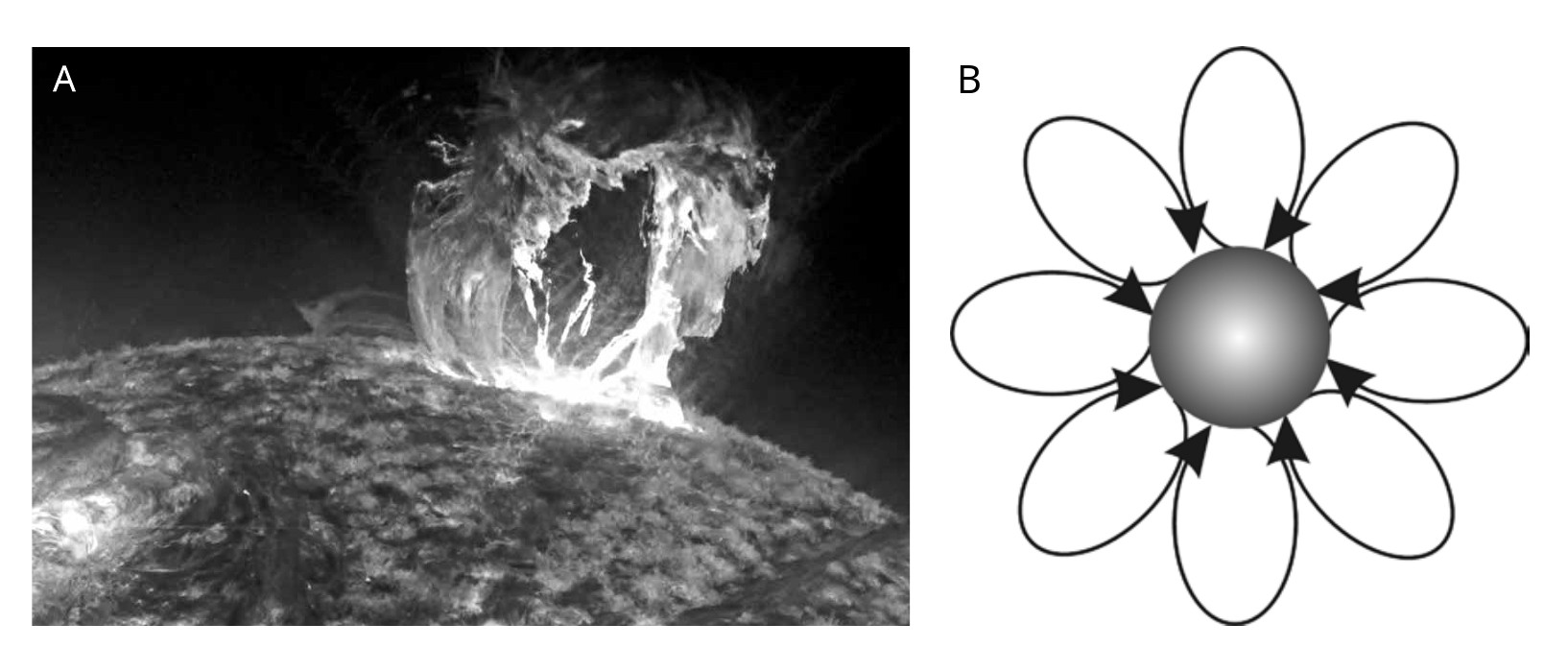 Fig. 2.27.
Fig. 2.27.
А. A giant prominence on the Sun. Such an ejection of matter from the Sun ends mostly with its fall back, although some of the matter and radiation escapes into open space.
B. If we "view" the Sun "through the camera" for a sufficiently large period of time, it will appear that the Sun is all covered with giant emissions forming loops around it. They can be called a material "coat" of the Sun (by analogy with a "coat" of virtual particles around, for example, a proton). A system, from the surface of which the material jets spout, will look as if clothed in a virtual "coat" during a long exposition
"Fontaning" is also observed in elementary particles. All particles are "dressed" in "coats" of other virtual particles. This means that each particle emits from itself other particles, which immediately return back and disappear. These fountains of virtual particles form "coats" around them. Thus, an electron is dressed in a "coat" of virtual electrons, positrons and photons; a nucleon is dressed in a "coat" of virtual pions, nucleon-antinucleon pairs and other strongly interacting particles3.
"Fountains" and every point of "empty" space - vacuum. Vacuum is continuously "boiling" with virtual particles, which are born and immediately disappear in the "void".
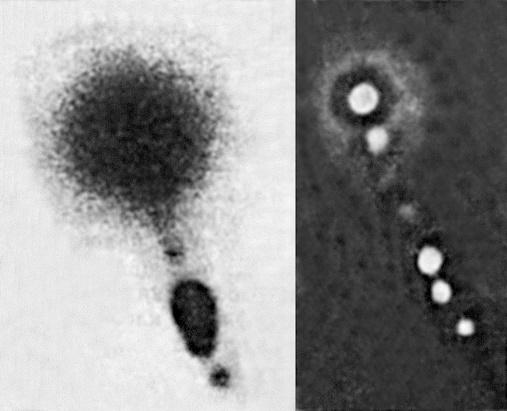
Fig. 2.28. Photograph of the nebula M87 = NGC 4486, which is the nucleus of the radio galaxy Virgo-A. The discrete ejection of matter from the galaxy nucleus can be clearly seen when photographing it in a different way

Fig. 2.29. Photograph of the galaxy M51. At the end of one of the spirals, a small galaxy companion is visible, which may well be an outburst from the active nucleus of this galaxy
There is an assumption4 that exactly this process is responsible for the vacuum temperature - 2.7 K (so-called relic radiation). So if for particles the process of birth from "emptiness" is virtual, then for energy, manifested in the vacuum temperature, is quite real!
S-Loops can also be found on the galactic scale floor. The nuclei of galaxies occasionally erupt with excess energy and eject jets and clots of matter (see Fig. 2.28). Due to gravity, these clots return back to the nucleus. If the ejection force exceeds a certain threshold, then so much matter and energy is ejected from the nucleus that a new galaxy is born (see Fig. 2.29).
On other floors of matter S-Loops are realized, apparently, according to a more complicated scheme. But, in general, it is obvious that energy and matter are bursting out of the depths of matter in its various material forms, which creates in the Universe a constant "pressure" from the lower levels of its structural structure. From the upper levels, gravity presses, which prevents matter from dispersing throughout the "empty" space and which forms planets, stars and galaxies from matter.
According to some models5, the mass of the Universe is such that gravitational forces will not let it fly apart finally, and sooner or later the great return of matter to the starting point will begin. The Universal M-loop will bend, and the motion of matter will reverse - the Universe will pass from the expansion stage to the contraction stage (see Fig. 2.23). Therefore, the most global scale loop can be considered to be the supposed cycle of the Universe: FROM THE BIG EXPLOSION FROM THE POINT TO THE EXPANSION AND BACK TO THE POINT. Of course, the whole Big Bang model is highly hypothetical, despite its many proponents in cosmology. We only show here that the S-loop has a theoretical possibility to be realized for the whole Universe.
But if the global S-loop originating in vacuum is only a theoretically admissible version, which cannot be checked, the existence of local fragments of M-loops in the form of white and black holes is confirmed by some astronomical observation6. While the former eject matter outwards, the latter, on the contrary, absorb it - so that it becomes invisible for an external observer.
How do black holes appear? When the gravitational forces are no longer counteracted by the internal pressure of the "burned out" star, if the mass of the star is greater than 2.5 solar masses, the core of the star shrinks to the size of the gravitational radius (about \(10^6\) cm) and goes beyond the event horizon7. What happens inside with the matter can only be guessed, here even theoretical calculations are sometimes powerless. In a neutron star, the density of matter is so great (of the order of \(10^{15}\) g/cm\(^3\)) that the electron shells of the atoms are stripped off, leaving solid nucleons compressed into a tight ball. In a black star hole, the density of matter will be higher by at least three orders of magnitude, and it is obvious that even elementary particles known to science today cannot exist there. In what form the matter will be presented, if the black hole will shrink to a point, as it is supposed by some models8, it is impossible to say at all. In addition to black holes with masses typical of stars, according to astronomers, there are almost certainly supermassive black holes located in the centers of galaxies.
But if the origin of black holes (BHs) is somehow explainable through gravitational collapse, then what forces of nature can generate white holes (WH) - remains a mystery. One thing is clear - a huge amount of matter is born from the "empty" space in the WH. Then we can correlate to WH the ascending branch of S-Loop, and to BH - the descending one.
The question arises: can there be a closed WH-BH process in the Cosmos, i.e. such a process in which all the matter born earlier in the WH would be pulled down in the BH with time? In this case, we would have a completely closed S-Loop, which would be a local model of the Big Bang. After all, here almost from a point of space can be born matter, which, filling the void around itself, can turn into a galaxy. In time, the whole galaxy can gather back to its center, and shrink to the state of the BH.
Such pulsation of matter is not as fantastic as it may seem at first sight. Many observational data can be interpreted as fragments of this process.
From the point of view of modeling processes in the form of S-Loops, the difference between vacuum boiling, proton surface, prominences on the Sun, galactic S-Loop, or global S-Loop consists only in the scale length of S-Loop and its starting point.
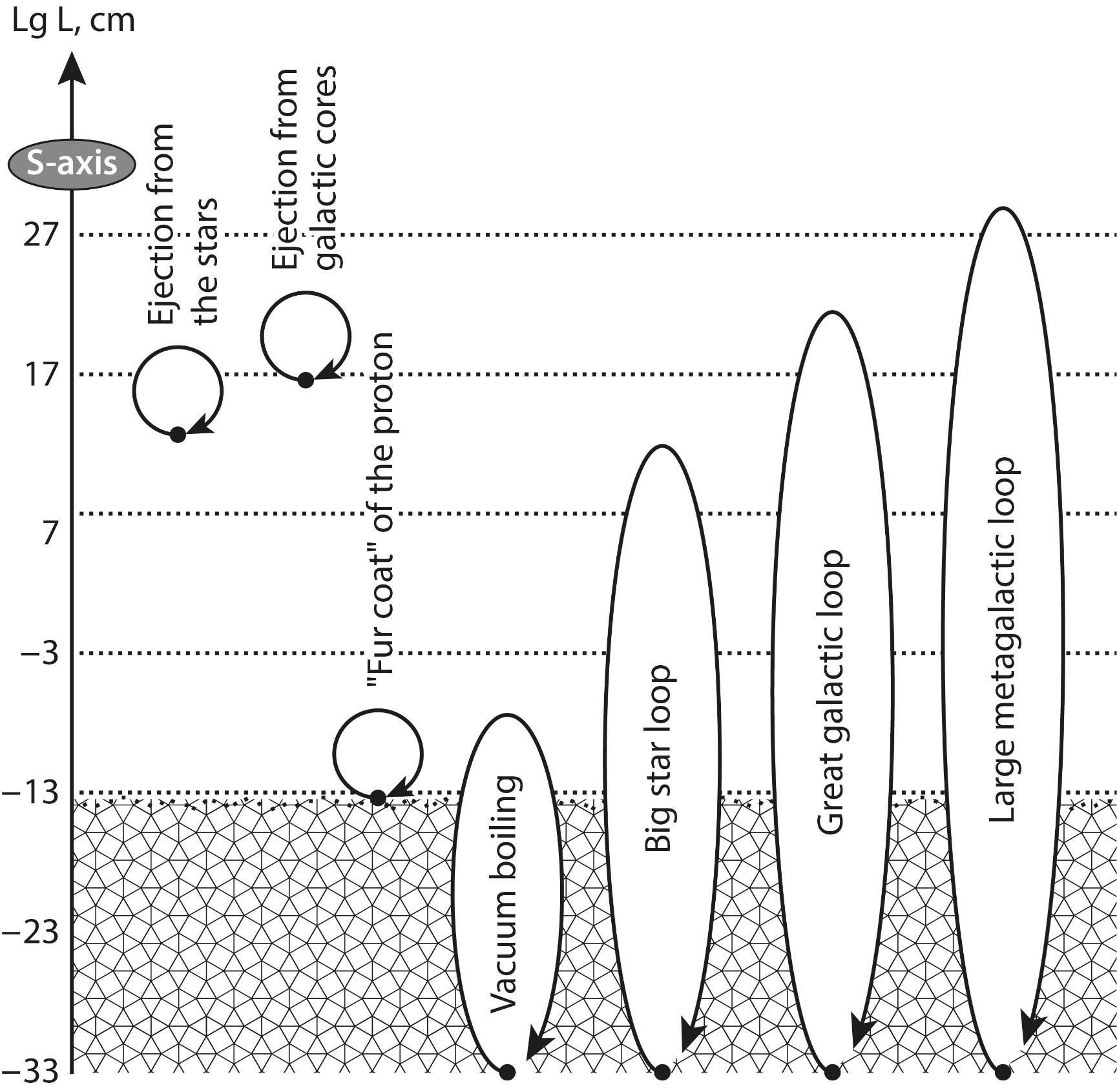
Fig. 2.30. Scheme of possible formation of different S-Loops. The loops may differ both in length and in the "depth" of nucleation. Shown on the right are four hypothetical large M-loops that could start at the maximon level
The latter, however, is likely to be rooted at the lowest structural level of matter, \(10^{-33}\) cm, in all cases (see Fig. 2.30).
Suppose that the substance has collapsed to the ground. If it is to the very bottom, then the excess energy will simply fly away into space and in this place will remain in time a "clean spot" of unperturbed ether, which will not be able to attract anything at all. Exactly to such final should come all black holes according to S. Hawking's version. But are there black holes that absorb everything around them? It should be a "pore in the ether", devoid of structure. We can say - pure matter is matter without structuring by its particles. And why not? Anything can happen in the Universe. If there can be resonant bubbles with the size of \(10^{-13}\) cm, there can be resonant bubbles with the size of \(10^7\) cm, and so on. "quantized" sizes. Of course, the division of the Universe into our world and the mirror world is a convention. The Universe is unified in these two of its manifestations, but science has so far studied only one of these sides. IT'S TIME TO SEE THE OTHER SIDE OF THE COIN.
So, we see that S-Loops are found on all floors of the Universe. They are a vivid example of S-Dynamics. The motion along the S-axis has a whole spectrum of sweeps, which determines the length of the S-Loop. The shortest S-Loops are "breaths", where the size changes by percentages and fractions of a percent. Next to that are "pulsations," a prime example being a heartbeat. In pulsations, the object is preserved, its integrity is not altered. The relative magnitude of pulsations can be either very small (e.g., heartbeat) or very large (e.g., - Cepheids, whose size changes up to two times). The author is not aware of pulsations with such a magnitude on the S-axis when the object would preserve its structure when its size changes by a factor of ten or more.
Next come all kinds of S-Loops with discontinuities. A rupture means that the object in the expansion phase loses its integrity and is dispersed in the environment. In general, the environment returns the matter to go back into the loop. For example, after the explosion of a supernova star, a huge part of the matter is dispersed in space, forming the diffuse matter of the galaxy. Subsequently, this matter participates in the process of compression and the birth of new stars, already richer in heavy elements. Thus, the cycle is completed. In other words, first the star, exploding, expands, while it moves along the S-axis to the right, but its integrity, "individuality", perishes in this process. The matter in this process is dispersed in space. After some time, the same matter (together with other matter) is compressed into a new star, and the cloud fragments into stellar embryos. The matter moves back along the S-axis, to the left. The length of the M-loop for collapsing stars exceeds 5-7 orders of magnitude along the S-axis.
We observe a similar picture of discontinuous S-loops in the Biosphere. Any organism dies, and the substance of its body is dispersed in the space of the planet. Subsequently, a new organism is born from this matter.
However, there is a significant difference from stars: in the Biosphere, each new organism is formed "around" a germ cell. This does not seem to be the case with stars.
The expansion to the right along the S-axis from the point of "person" we will call the right loop. The embryo, gathering around itself the substance from the environment, grows rapidly, moving upward along the S-axis. In the S-diagram, this process can be represented as a left S-loop. If we combine these two processes, we get a kind of S-eight (see Fig. 2.32), which may not always be symmetrical, most likely, its upper loop is always longer than the lower one, and besides, its upper branch has a break. Does not the example with biosystems suggest to us that the birth of new stars must also have an embryo?
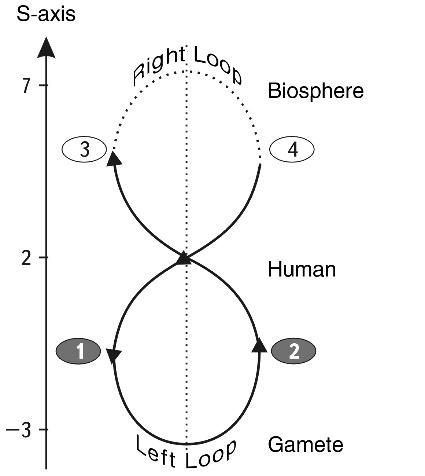
Fig. 2.32. Schematic S-loop for a human (similar to the Mobius ribbon). 1 - formation of a germ cell and conception; 2. - fetal growth and birth; 3. - Dispersion of human matter in the Biosphere after death; 4. - collection of matter from the Biosphere in the process of human growth and life
What if, for example, such an embryo could be a neutron star? If the M-similarity is realized here, astrophysics will have to reconsider the theory of star birth.
But one can also find examples of indisputable similarity. It is known from biology that when members of a population die en masse, its birth rate increases.
Thus, death acts as a stimulant for the reproduction of biosystems.
We see something similar in the cosmos. The explosions of supernovae violate the gravitational stability of the gas-dust complexes of the interstellar medium, which leads to the beginning of its fragmentation, compression, and, finally. - to the formation of new stars, i.e. (similarly to the situation with biosystems) death acts as a stimulant of birth.
Let us return once again to the hereditary S-loop. For a human, the M-loop can be well investigated at the level of its lower half, at the moment when a sex cell appears. It is likely that the properties of the sex cell are determined not only by the genetic material transferred to it, but also by the whole state of the organism (taking into account the science of astrology - also by the properties of the whole solar system, and possibly the whole Universe). A sex cell, moving from the place of its formation to the place of meeting with another sex cell, remains at the same scale level. The synthesis of two sex cells leads to the beginning of the process of development of a new organism, i.e. upward movement along the S-axis. Thus, we can clearly trace in this process the unbroken lower part of the "S-Eight", while its upper part is broken in the medium (see Fig. 2.32).
It can be noted that such S-LETTERS OF TRANSFORMATION go beyond the limits of a particular S-CLASS. In other words, a star cannot beget a galaxy, a human being cannot beget a star, etc. The process of rebirth takes place within its own class. But if we examine the upper half of the eight more closely, we find that it does open up into a neighboring class. Thus, the substance that goes to create a new organism comes not only from the Earth, but also from the cosmos9 from the space of the Solar System, hence, not only the stellar level, but also the galactic level is involved in the creation of each organism on the Earth, since the interstellar substance coming to the Earth is collected in the galactic expanse. On the other hand, we are talking about the matter which is born in the depths of stars, hence, if in the spatial understanding, it comes from the galactic level, in the large-scale understanding it comes from the level of stars. Similarly, for stars, it is unlikely that the matter for them comes from neighboring galaxies, most likely, galaxies are closed by matter flow.
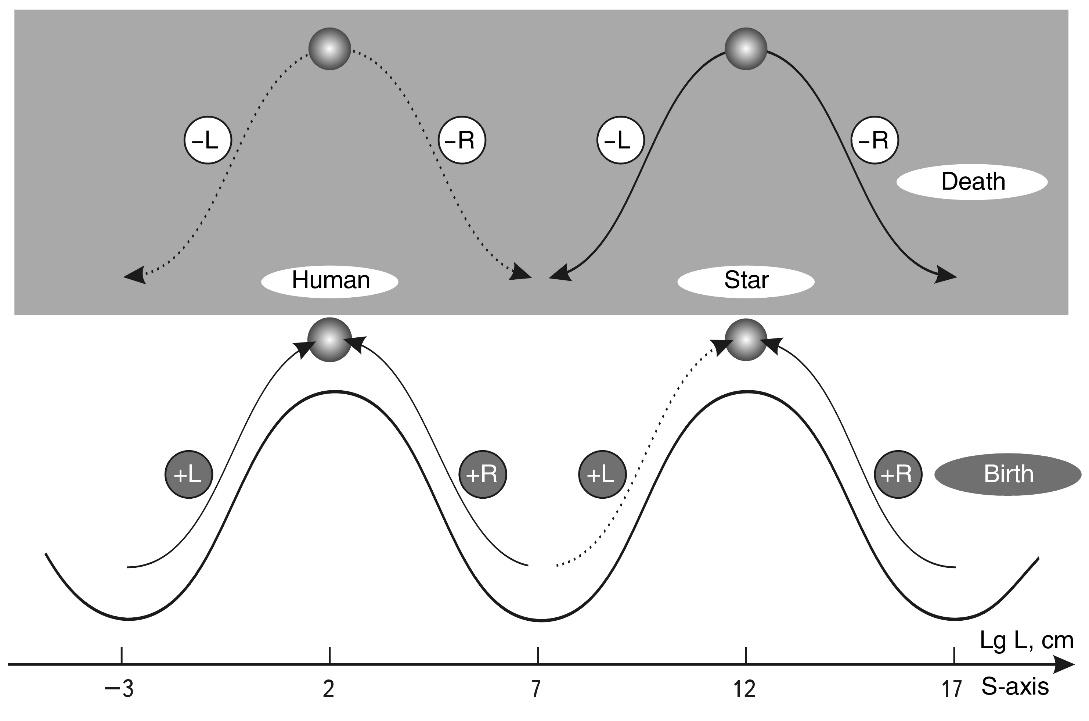
Fig. 2.33. S-diagrams of birth and death for a human and a star. The dotted line shows the assumed, not yet scientifically revealed trajectories
By the way, the presence of an embryo necessary for the birth of cosmic objects is hypothetical only for stars. For galaxies, the presence of the embryo, perhaps, is not in doubt. Most likely such are quasars.
The size of quasars is about 5 orders of magnitude smaller than the galactic size, but their active energy and the fact that they are surrounded by nebulae, whose sizes already relate to the typical sizes of galaxies, give reason to PREPARE that we see the beginning of the birth process of a new galaxy, which grows out of a quasar in a time comparable in proportions to the time of growth of the embryo of the Biosystem10. Here we see the manifested right positive S-vector (see Fig. 2.33).
-
Polyan V. I. Channels of Life. Novosibirsk: NKI, 1990. P. 7. ↩
-
Yavorsky B. M., Detlaf A. A. Handbook of Physics. Moscow: Nauka. Fizmatlit, 1996. P. 545. ↩
-
Shirokov Yu. M., Yudin N. P. Nuclear Physics. Moscow: Nauka, 1972. P. 316. ↩
-
Khodkov A. E., Vinogradova M. G. On Core Problems of Natural Science. St. Petersburg: Nedra, 1977. P. 29. ↩
-
Markov M. A. On the Nature of Matter. Moscow: Nauka, 1976. ↩
-
Penrose R. Singularities in Cosmology // Cosmology. Theories and Observations. Moscow: Mir, 1978. P. 336–348. ↩
-
Mitton S., Mitton J. Astronomy. Moscow: Rosman, 1995. P. 120. ↩
-
Shklovsky I. S. Stars. Their Birth, Life, and Death. Moscow: Nauka, 1977. ↩
-
Sukhonos S. I. Does Cosmic Dust Stimulate Evolution? // Chemistry and Life. № 1. P. 91–93. ↩
-
Sukhonos S. I. A View from Afar // Knowledge and Power.— 1981.— № 7. P. 31–33. ↩